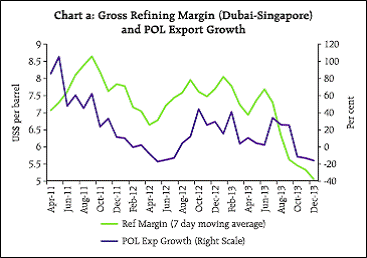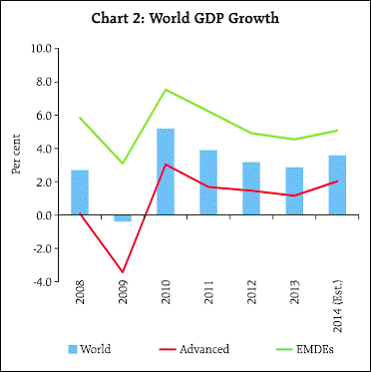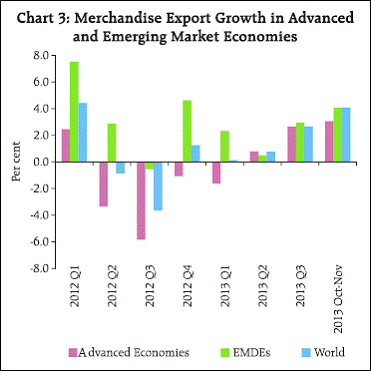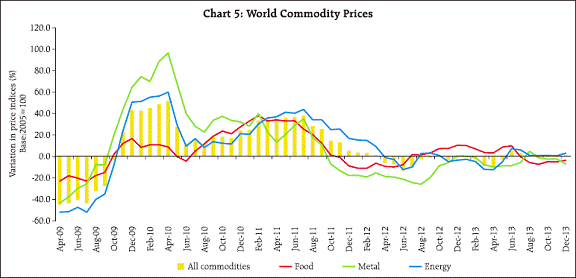India’s Foreign Trade: April-December 2013 - ربی - Reserve Bank of India
India’s Foreign Trade: April-December 2013
India’s trade performance improved during April- December 2013 as compared with the April-December 2012. Modest pick-up in some trade partner economies and depreciation of the rupee helped India’s exports to grow in Q2 and Q3 of 2013-14. Imports also moderated since June 2013, largely driven by non-oil imports. This led to a significant correction in India’s trade balance in April-December 2013. Lower merchandise trade deficit augured well for minimising external sector vulnerabilities. Although India’s export performance is largely contingent on the pace of economic activity in major trade partner economies, moderation in export growth in November and December 2013 raises concern about its sustainability. Further, revival in domestic investment cycle and trends in international prices of key import commodities (e.g., crude oil and gold) would be pertinent for India’s import demand. In short, the trend in India’s trade balance would continue to depend on a confluence of both domestic and global factors. I. India’s Merchandise Trade Exports (April-December 2013) Although the 2013-14 began with subdued export trends, renewed global demand and rupee depreciation seem to have benefitted India’s exports in subsequent months. On cumulative basis, exports improved during April-December 2013, although the pace of export growth was largely uneven. After declining in Q1, exports recovered in Q2 and continued to grow in Q3 albeit at slower pace. On cumulative basis, export performance was broadbased across all major sectors and amongst all major export destinations. On a cumulative basis, exports grew by 5.5 per cent to US$ 229.3 billion during April-December of 2013 as against a decline of 4 per cent at US$ 217.4 billion during April-December 2012 (Table 1) (Chart 1). With moderation in export growth recorded since November 2013, attainment of export target set for 2013-14 (US$ 325 billion) may be difficult and at best exports may be modestly higher than the previous year’s level.
Commodity-wise and Destination-wise Exports (April - December 2013) Disaggregated commodity-wise data show that the rise in total exports during April-December of 2013 can be primarily attributed to the turnaround in the exports of manufactured goods. Among other categories, exports of petroleum products grew at a moderate pace than in the corresponding period of 2012 while growth in exports of agricultural goods moderated despite a rise in exports of principal primary commodities like rice, oilmeal and marine products (Table 2). Notwithstanding a lower growth in agricultural and allied products, exports of primary products registered higher growth primarily on account of higher exports of ores and minerals. However, iron ore sector continues to face supply side constraints in major iron producer states like Orissa, Karnataka and Goa. In Karnataka, the annual production of iron ore continues to remain capped at 30 million tonnes and exports are banned, although the mining ban has been lifted in April 2013. Moderation in exports of agriculture and allied products was mainly led by either a moderation or decline in exports of major commodities, viz., tea, coffee, wheat, spices and sugar & molasses. There was, however, a significant growth in exports of rice, cashew, cotton raw, oil meal and marine products during April-December 2013 as against a decline during April-December 2012. Increase in rice exports was on account of higher shipments of basmati rice to Iran which was unable to procure foodgrains from other countries in the presence of US sanctions against Iran. Similarly, exports of oil meals grew due to higher demand from countries like South Korea, Iran and Europe.
Within the manufacturing sector, export growth in almost all the major product groups, viz., ‘leather & manufacture’, ‘chemicals & related products’, ‘textile & textile products’ and ‘handicrafts’ turned positive during April-December 2013 as against a decline during April-December 2012. The recovery was more prominent in exports of ‘transport equipments’ and ‘iron & steel’ which registered a growth of 11.4 per cent and 30.9 per cent, respectively during April- December 2013 owing to renewed demand from select advanced economies, particularly, US and EU. Decline in exports of ‘gems & jewellery’, however, continued during April-December 2013. Fall in value of exports of gems and jewellery could partly be on account of softening of global prices of precious metals (e.g., gold) which are used as basic input in gems and jewellery sector. It may be noted that gold prices declined by 20 per cent during April-December 2013 (y-o-y). Sharp rise in ‘textile & textile products’, by about 16 per cent during April December 2013 as against a decline of 5.1 per cent during April-December 2012, can be attributed primarily to the growth in exports of readymade garments, cotton yarn and manmade fibre. Export revival in garment sector is mainly attributed to recovery in the US and the European Union markets, efforts towards tapping opportunities in non-traditional markets, rupee depreciation and orders flowing to India because of higher production cost in China (Business Line, December 15, 2013). Although, on cumulative basis, export growth was higher in April-December 2013, a few export sectors have witnessed slowdown in recent months (Box 1). Box 1: Recent Slowdown in Exports from Select Sectors India’s exports have shown improvement during April-December 2013. However, during November and December 2013, exports from certain major sectors including petroleum products, gems and jewellery and drugs and pharmaceutical became subdued. Slowdown in exports from these sectors could be attributed to both domestic and global factors. Besides temporary shutdown in some petroleum refineries for maintenance, declining gross refining margins, a common proxy for trends in profitability seem to have weighed on India’s exports of petroleum products (Chart a). Gross refinery margins (e.g., Singapore GRM, a benchmark for all Asian refiners) have remained weak owing to wide gap between demand and supply of petroleum products as well as narrowing of light-heavy crude differential in recent months. Gems and jewellery sector, accounting for nearly 13 per cent of India’s merchandise exports, recorded a decline of 6.9 per cent in exports during April-December 2013. Decline in exports of gems and jewellery sector reflects inter alia significant softening of international prices of precious metals like gold and silver during April-December 2013 (Chart b) and sluggish demand in key markets such as the United Arab Emirates (UAE), the US and Europe. Another sector that has seen lower exports in some recent months is drugs and pharmaceuticals. Sluggishness in drugs and pharma exports could inter alia be on account of growing concerns abroad on safety standards including in the US. Importantly, India is the second largest supplier of drug to the United States, supplying about 40 percent of generic and over-the-counter drugs. Another factor that seems to have impacted India’s exports from this sector is increasing competition from China, particularly in the segment of contract manufacturing, in recent period. Broad based export growth was also reflected in the improved export performance across major export destinations. Among the major trade partners, exports to the US, Belgium, Italy, Germany, the UK, Japan, Iran, China, Hong Kong, Malaysia, exhibited a considerable rise during April-December of 2013 (Table 3). Exports to UAE, South Korea, Netherlands and Latin American countries, however, witnessed a decline during April-December of 2013. The US continues to be the major export destination for India with a share of 12.8 per cent of India’s exports, followed by UAE accounting for 9.8 per cent, China (4.8 per cent) and Singapore (4.5 per cent).
Pick-up in exports to the major trade partners seems to have been supported by growth recovery in these economies in recent quarters (Table 4). Going forward, the pace of economic activity in these economies would be pertinent for sustained rise in India’s exports as income elasticity of India’s exports is generally considered to be high. Rise in exports to EU, North America and Developing Asia was reflected in the increase in their relative contribution during April-December 2013 which, however, turned negative, in case of OPEC, Eastern Europe and Latin America (Table 5). Imports (April-December 2013) Moderation in merchandise imports which began in June 2013 intensified further in Q3 of 2013-14. On cumulative basis, India’s merchandise imports recorded a decline of 6.5 per cent in April- December 2013 at US$ 340.5 billion as compared with a marginal increase of 0.1 per cent at US$ 364.2 billion in April-December 2012 (Table 1). In India, measures aimed at curbing gold imports, as well as weaker domestic demand, helped reducing merchandise imports during the period. Commodity-wise and Destination-wise Imports (April-December 2013) Commodity-wise, the import decline during April-December of 2013-14 could be attributed to lower imports of gold & silver, capital goods, iron & steel, coal and fertilisers. Growth in POL imports sharply decelerated to 2.7 per cent in April-December 2013 as compared with 9.8 per cent in April-December 2012. Moderation in import growth of POL products largely reflects fall in international crude oil prices by 2 per cent and a marginal increase in quantum of POL imports during April-December 2013 (y-o-y) (Table 6). Consequent on various gold import measures undertaken during the year, downward trend in gold imports began in July 2013. On cumulative basis, imports of gold and silver contracted by 33.9 per cent (only gold by 38 per cent) during April-December 2013, accounting for nearly 53 per cent of total decline in merchandise imports. Among other components, decline in imports of capital goods pronounced further in April-December 2013 indicating slower domestic investment activity. In contrast, imports of export related items (particularly pearl, precious and semi-precious stone), witnessed a growth of 9.7 per cent in April-December 2013 as against a decline of 16.1 per cent in April-December 2012 (Table 7).
Destination-wise data reveal that decline in India’s imports were mainly from trade partner countries, viz., the EU, the US, Japan, China, Switzerland, the UAE, South Korea, Iran and Malaysia. In contrast, imports from the UK, Saudi Arabia, Kuwait recorded an increase over the corresponding period (Table 8).
In terms of share, China, despite a fall in imports, continued to be the main import source for India accounting for 11.4 per cent of total merchandise imports during April-December 2013. With a sharp fall in imports from UAE, Saudi Arabia replaced it as the second largest source country for imports, followed by the UAE, the US and Iraq. Region-wise, while the respective share of OPEC and developing Asian region (excluding OPEC and Japan) in India’s merchandise imports increased, that of the OECD group of economies declined. Trade Deficit With recovery in exports and fall in imports especially in Q2 and Q3 of 2013-14, India’s trade deficit stood at US$ 111.3 billion during April- December 2013, almost 24 per cent lower than that in the corresponding period of 2012-13. While exchange rate adjustments and recovery in global demand may have facilitated exports, moderation in imports was primarily led by a sharp decline in imports of gold, consequent upon the various measures undertaken by the Government and the Reserve Bank of India.
II. Global Trade Global economic growth remained slow and uneven in 2013 albeit a moderate expansion was witnessed in the second half of 2013, largely supported by select advanced economies. Accordingly, the growth in volume of world trade remained almost stagnant in 2013. According to CPB Trade Monitor (December 2013)1, pace of trade activities varied across countries in 2013. While contraction in imports of advanced economies persisted in 2013, trade activity within emerging economies gathered momentum (Chart 3). However, global economic prospects seem better in 2014 as pick-up in growth momentum is projected for many advanced economies and emerging market economies may also recover at a modest pace (Chart 2). According to the IMF (January 2014), the world trade volume is projected to grow by 4.5 per cent in 2014 as compared with 2.7 per cent in 2013 (Chart 4). With the exception of energy, all the key commodity price indices declined significantly in 2013. International oil prices have fluctuated in a narrow range in 2013 and largely determined by geopolitical concerns in middle-east countries and rapid expansion of unconventional oil production in the US. However, going forward, there may be downside risks for international oil prices coming from moderate growth in major oil consumer countries and substitution between oil and gas in the medium to long run scenario. These downside risks, however, may be offset supply constraints due to geo-political concerns in gulf area (Chart 5). Metal prices have remained moderate in recent quarters mainly reflecting subdued demand growth and strong supply response supported by high investment in earlier years in expectation of high metal prices. However, going forward, trend in metal prices will be largely determined by growth scenario in countries like China which accounts for almost 45 percent of global metal consumption. Fall in prices of precious metals in 2013 also reflects demand turning subdued due to changing perceptions of global risk and inflation, given gold’s considered as a “safe-haven” asset. With on-going tapering of bond purchases by the US Federal Reserve and lower demand for gold in major gold importing countries like India, the prices of precious metal may remain subject to downward pressure. A significant fall in food prices reflects the free-fall of maize and rice prices by 36 per cent and 25 per cent, respectively during March to December 2013 aided by a continually improving supply prospects. As normal weather conditions are anticipated in major food producer countries, easy supply may keep international food prices low. III. Outlook Global economic environment has improved and world trade volume has picked up since H2 of 2013 which has benefitted India’s exports in recent period. However, recovery in advanced and major emerging market economies needs to become more durable to ensure sustainable demand for India’s export which recorded somewhat moderate growth in Q3 of 2013- 14 as compared with the preceding quarter. At this pace of export growth, attainment of export target of US$ 325 billion during 2013-14 may be difficult. Notwithstanding some moderation in export growth in Q3 vis-à-vis Q2, India’s merchandise trade deficit remained stable at US$ 29.9 billion in Q3, aided by significant contraction in demand for non-oil import, particularly gold and capital goods. Fall in capital goods in Q3 of 2013-14 reflects persistence of subdued investment climate in the domestic economy. If export decline in major export sectors, viz., petroleum products and gems & jewellery, prolongs and is not offset by concomitant fall in imports, it may not augur well for India’s trade deficit. Importantly, the lower trade deficit has helped narrowing India’s current account deficit within sustainable limits in recent quarters. Going forward, export growth would not only largely depend on pace of economic activity in India’s major trade partner economies, it would also depend on how major issues constraining India’s export prospects are addressed. Further, trend in import would be contingent on how fast domestic investment cycle revives as it would have implications for import demand. Besides, the international prices of key import commodities like crude oil would also be critical for India’s overall trade balance. Detailed information on monthly commoditywise and country-wise data on merchandise exports and imports for 2012-13 and April-December 2013 can be accessed at /en/web/rbi/press-releases. * Prepared in the Division of International Trade and Finance, Department of Economic and Policy Research. The previous issue of the article was published in the Reserve Bank Bulletin, January 2014. 1Released by CPB Netherlands Bureau for Economic Policy Analysis in February 2014. |
||||||||||||||||||||||||||||||||||||||||||||||||||||||||||||||||||||||||||||||||||||||||||||||||||||||||||||||||||||||||||||||||||||||||||||||||||||||||||||||||||||||||||||||||||||||||||||||||||||||||||||||||||||||||||||||||||||||||||||||||||||||||||||||||||||||||||||||||||||||||||||||||||||||||||||||||||||||||||||||||||||||||||||||||||||||||||||||||||||||||||||||||||||||||||||||||||||||||||||||||||||||||||||||||||||||||||||||||||||||||||||||||||||||||||||||||||||||||||||||||||||||||||||||||||||||||||||||||||||||||||||||||||||||||||||||||||||||||||||||||||||||||||||||||||||||||||||||||||||||||||||||||||||||||||||||||||||||||































